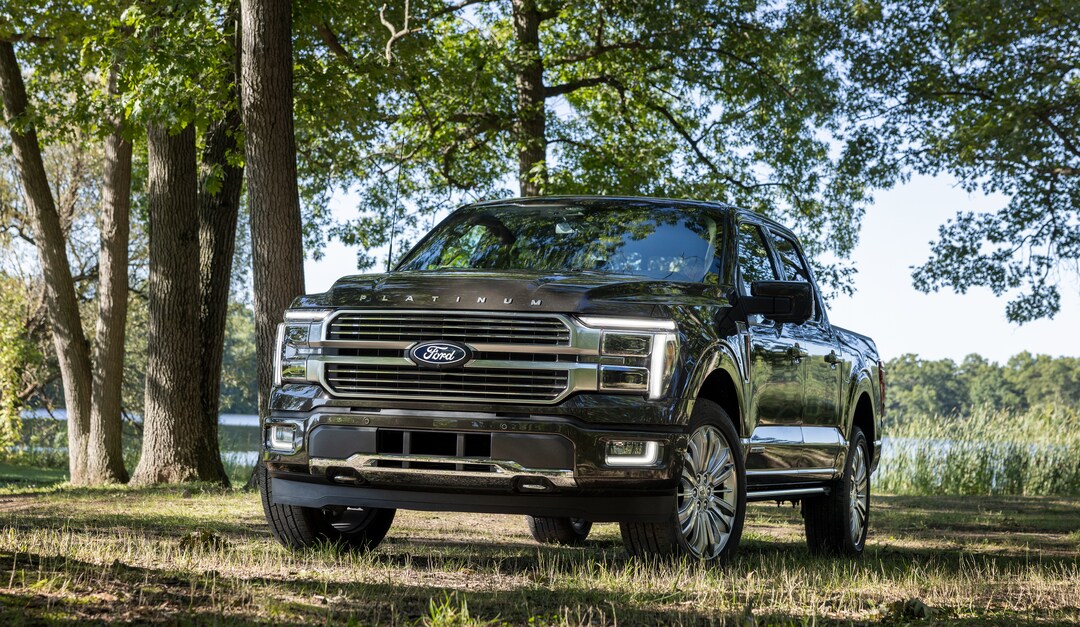
Comparing the Ford F-150 vs. Silverado 1500
Comparing the Ford F-150 vs. Chevy Silverado 1500
Shoppers comparing full-size and midsize truck options tend to start with two of the biggest names: the Ford F-150 and Chevy Silverado 1500. Both trucks have V6 and V8 options, excellent towing strength, and generous trim offerings. However, the Ford F-150 has a more robust powertrain lineup, smarter technology integration, and more purpose-built configurations, from hybrid to off-road-tuned to heavy hauler. In daily use and high-demand jobs, the Ford F-150 outpaces the Silverado in torque responsiveness, payload control, and adaptability.
| Ford F-150 | Chevy Silverado 1500 | |
|---|---|---|
| Engine Power | 400 hp @ 6,000 rpm | 310 hp @ 5,600 rpm |
| Engine Torque | 410 lb-ft @ 4,250 rpm | 430 lb-ft @ 3,000 rpm |
| Engine displacement | 5.0 l | 2.7 l |
| Fuel Capacity | 36.0 gal. | 24.0 gal |
| Transmission | 10-speed shiftable automatic | 8-speed shiftable automatic |
| Engine configuration | V8 | inline 4 |
Performance Capabilities
The Ford F-150 truck lineup includes a 3.3-liter V6, 2.7-liter EcoBoost® V6, 3.5-liter EcoBoost® V6, 5.0-liter V8, and a 3.5-liter PowerBoost™ hybrid-all paired with a 10-speed automatic transmission. Output peaks at 430 horsepower and 570 pound-feet of torque with the hybrid.
- 2.7-liter EcoBoost V6 making 325 horsepower and 400 pound-feet of torque
- 5.0-liter V8 making 400 horsepower and 410 pound-feet of torque
- 3.5-liter EcoBoost V6 making 400 horsepower and 500 pound-feet of torque
- High-output 3.5-liter EcoBoost V6 making 450horsepower and 510 pound-feet of torque
- 3.5-liter PowerBoost Hybrid V6 making 430 horsepower and 570 pound-feet of torque
- High-output Supercharged 5.2-liter V8 making 720 horsepower and 640 pound-feet of torque
Ford F-150 trucks are engineered for heavy lifting, with a maximum towing capacity of 16,500 pounds and a 2,440-pound maximum payload.
The Chevy Silverado 1500 lineup offers 2.7-liter TurboMax, 5.3-liter and 6.2-liter V8, and 3.0-liter Duramax turbo-diesel engines with outputs reaching 420 horsepower and 495 pound-feet of torque. It has a maximum towing capacity of up to 13,500 pounds with a 2,455-pound payload.
The Ford F-150 responds with better balance under load, especially with trailer sway control and Pro Trailer Backup Assist™.
Off-Road Readiness
These full-size and midsize trucks cover off-road needs, but Ford edges out with better trail-specific control and stronger damping. The Silverado ZR2 rides high with Multimatic DSSV dampers and a 2-speed transfer case, but Chevy's suspension tuning favors wide-open terrain. Raptor and Tremor trims offer deeper articulation, increased ground clearance, and multiple skid plate layers for tighter, technical routes.
The Ford F-150 Raptor features long-travel suspension and 37-inch tires-something the Silverado ZR2 skips entirely. In real time, the Ford Trail Control and selectable terrain modes adapt throttle response for sand, rock, mud, or snow. Chevy's terrain mode lacks the same granularity and response.
Interior Amenities
Ford F-150 cabins run quieter, especially in Lariat and higher trims, thanks to active noise cancellation and thicker acoustic glass. Front-row options include max-recline seats that fold nearly flat, wide bolsters, and integrated massage settings on higher trims. Seating in the Silverado is firm but lacks the same range of adjustability.
Full-size and midsize truck customers expect three cab styles and multiple bed lengths, and they both deliver. The Ford F-150 distinguishes itself in its cargo storage. It has an available Interior Work Surface and lockable under-seat storage. Silverado includes storage cubbies behind the rear seatbacks, but the layout feels cramped by comparison.
The Ford tailgate technology also wins utility points. The available Tailgate Work Surface and Pro Power Onboard generator simplify jobsite tasks, even without shore power. The Chevy Multi-Flex tailgate adds versatility but lacks integrated power support and ties directly to fewer work applications.
Technology and Safety Features
The Ford SYNC® 4 infotainment system feels modern, fast, and customizable. The 12-inch touchscreen and digital instrument cluster scale naturally with trim level, and voice commands rarely miss. The Silverado infotainment system looks bright but lags under load and restricts layout changes.
Ford also integrates over-the-air software updates, onboard scales, and BlueCruise hands-free driving on compatible highways. Silverado offers Super Cruise on top-tier trims, but it's limited in availability and does not include the same trailer mapping features.
Safety is a priority in the full-size and midsize truck segments. The Ford F-150 has more standard-equipped safety technology, including
- Pre-Collision Assist with Automatic Emergency Braking
- Rear View Camera with Dynamic Hitch Assist
- Post-Collision Braking
Chevy includes Forward Collision Alert and Lane Keep Assist, but some of the Silverado's driver assistance features are dedicated to the top trims.

Visit Spring Valley Ford and Schedule a Test Drive Today
Spring Valley Ford has a great selection of full-size and midsize trucks for sale that are ready for daily hauling, weekend towing, and job site demands. Explore our Ford F-150 truck inventory, compare trims and configuration options, and take a test drive in the ones that pique your interest.
-
Spring Valley Ford
#2 Joseph Ruva Drive
Spring Valley, IL 61362
- Sales: (815) 664-4512
How can we help?
* Indicates a required field



